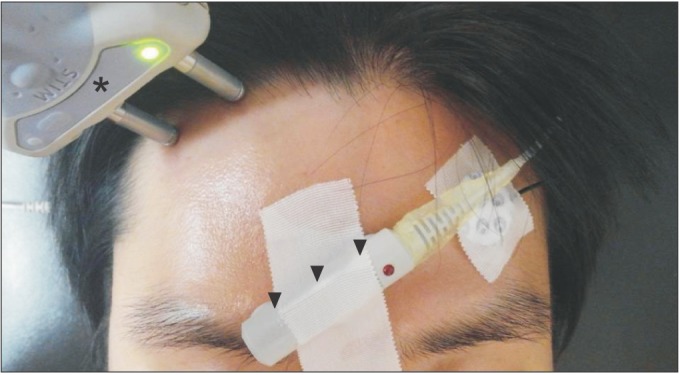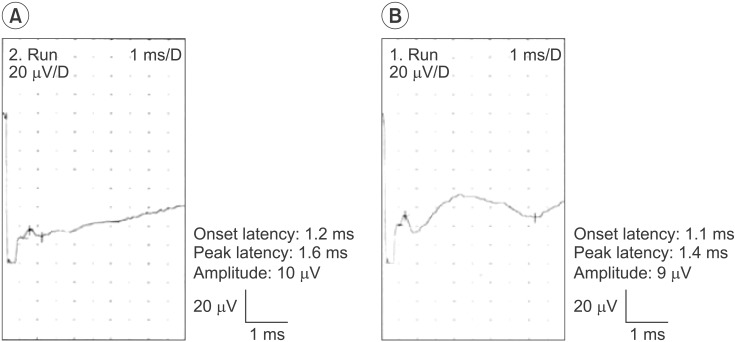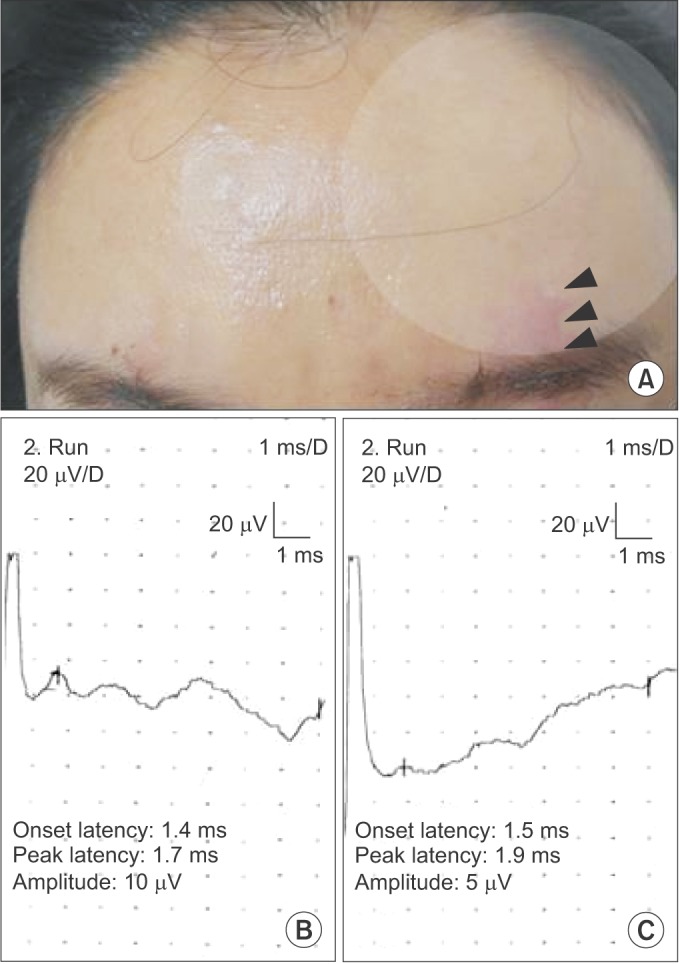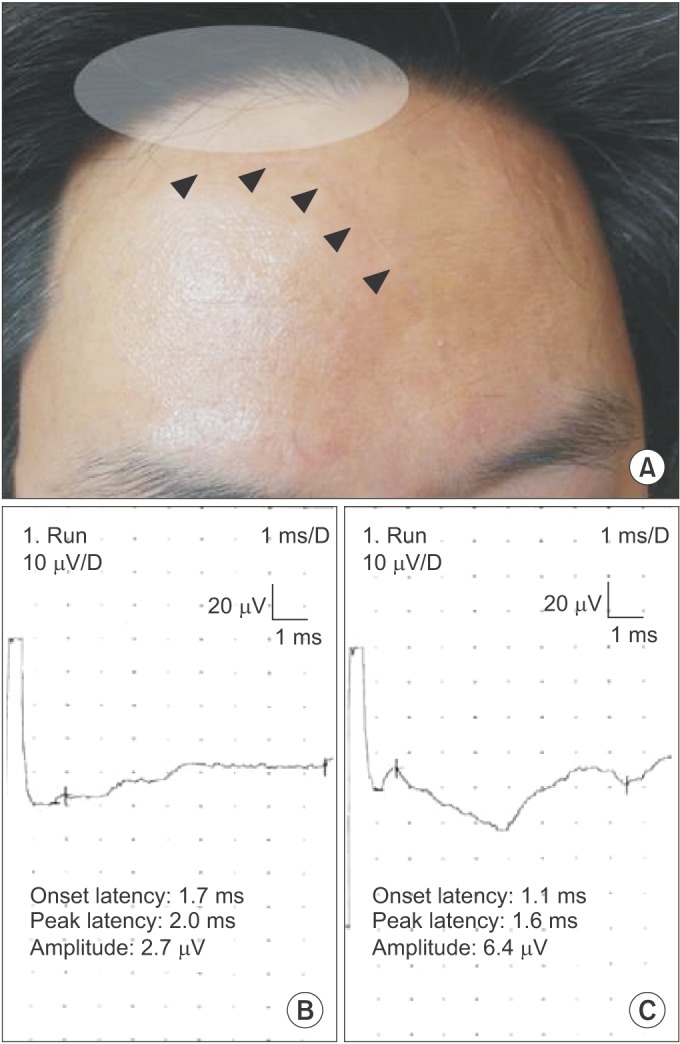Ann Rehabil Med.
2016 Feb;40(1):43-49. 10.5535/arm.2016.40.1.43.
Reappraisal of Supraorbital Sensory Nerve Conduction Recordings: Orthodromic and Antidromic Techniques
- Affiliations
-
- 1Department of Physical Medicine and Rehabilitation, Korea University School of Medicine, Seoul, Korea. hkkwon@korea.ac.kr
- KMID: 2155164
- DOI: http://doi.org/10.5535/arm.2016.40.1.43
Abstract
OBJECTIVE
To establish a supraorbital nerve sensory conduction recording method and assess its usefulness.
METHODS
Thirty-one healthy subjects without a history of trauma or neurological disease were recruited. For the orthodromic procedure, the recording electrode was attached immediately superior to the supraorbital notch. The stimulation electrode was placed on points along the hairline which evoked the largest sensory nerve action potentials (SNAPs). The antidromic sensory response was recorded after switching the recording and stimulating electrodes. The measured parameters were onset latency, peak latency, and baseline to peak amplitude of the SNAPs. The electrophysiological parameters of the bilateral supraorbital nerves were compared. We also recruited two patients who had sensory deficits on one side of their foreheads because of laceration injuries.
RESULTS
The parameters of orthodromically recorded SNAPs were as follows: onset latency 1.21±0.22 ms (range, 0.9-1.6 ms), peak latency 1.54±0.23 ms (range, 1.2-2.2 ms), and baseline to peak amplitude 4.16±1.92 µV (range, 1.4-10 µV). Those of antidromically recorded SNAPs were onset latency 1.31±0.27 ms (range, 0.8-1.7 ms), peak latency 1.62±0.29 ms (range, 1.3-2.2 ms), and baseline to peak amplitude 4.00±1.89 µV (range, 1.5-9.0 µV). There was no statistical difference in onset latency, peak latency, or baseline to peak amplitude between the responses obtained using the orthodromic and antidromic methods, and the parameters also revealed no statistical difference between the supraorbital nerves on both sides.
CONCLUSION
We have successfully recorded supraorbital SNAPs. This conduction technique could be quite useful in evaluating patients with supraorbital nerve lesions.
Figure
Reference
-
1. Penas-Prado M, Martinez-Salio A, Porta-Etessam J, Villarejo-Galende A, Garcia-Ramos R, Saiz-Diaz RA, et al. Post-traumatic supraorbital neuralgia: a benign condition. Rev Neurol. 2007; 44:89–91. PMID: 17236147.2. Knize DM. A study of the supraorbital nerve. Plast Reconstr Surg. 1995; 96:564–569. PMID: 7638280.
Article3. Erdogmus S, Govsa F. Anatomy of the supraorbital region and the evaluation of it for the reconstruction of facial defects. J Craniofac Surg. 2007; 18:104–112. PMID: 17251847.
Article4. Benvenuti D. Endoscopic brow lifts with injury to the supraorbital nerve and neuroma formation. Plast Reconstr Surg. 1999; 104:297–298. PMID: 10597712.
Article5. Bovim G, Sand T. Cervicogenic headache, migraine without aura and tension-type headache: diagnostic blockade of greater occipital and supra-orbital nerves. Pain. 1992; 51:43–48. PMID: 1454403.
Article6. Caputi CA, Firetto V. Therapeutic blockade of greater occipital and supraorbital nerves in migraine patients. Headache. 1997; 37:174–179. PMID: 9100402.
Article7. Hemmi S, Kurokawa K, Nagai T, Murakami T, Sunada Y. A novel method to measure sensory nerve conduction of the supraclavicular nerve. Muscle Nerve. 2014; 50:1005–1007. PMID: 25042692.
Article8. Marchini C, Zambito Marsala S, Fabris F, Fornasier A, Ferracci F. Peroneal nerve orthodromic sensory conduction technique: normative data. Neurol Sci. 2009; 30:201–205. PMID: 19238315.
Article9. Raffaele R, Emery P, Palmeri A, Ricca G, Perciavalle V. Sensory nerve conduction velocity of the trigeminal nerve. Electromyogr Clin Neurophysiol. 1987; 27:115–117. PMID: 3582256.10. Therimadasamy A, Wilder-Smith EP, Lim AY, Yap YL, Yeo M, Naidu S, et al. Supraorbital nerve conduction study in normal subjects. Muscle Nerve. 2012; 45:603–604. PMID: 22431095.
Article11. Oh SJ. Clinical electromyography: nerve conduction studies. 3rd ed. Philadelphia: Lippincott Williams & Wilkins;2003.12. Liveson JA, Ma DM. Laboratory reference for clinical neurophysiology. Philadelphia: F. A. Davis;1992.13. Shahani B. The human blink reflex. J Neurol Neurosurg Psychiatry. 1970; 33:792–800. PMID: 5531899.
Article14. Jandolo B, Gessini L, Pietrangeli A. Conduction velocity in the human supraorbital nerve. Eur Neurol. 1981; 20:421–423. PMID: 6974645.
Article15. Aminoff MJ. Electromyography in clinical practice. Menlo Park: Addison-Wesley;1978.16. Kimura J. Electrodiagnosis in diseases of nerve and muscle: principles and practice. 2nd ed. Philadelphia: F. A. Davis;1989.17. Christensen KN, Lachman N, Pawlina W, Baum CL. Cutaneous depth of the supraorbital nerve: a cadaveric anatomic study with clinical applications to dermatology. Dermatol Surg. 2014; 40:1342–1348. PMID: 25357169.18. Cuzalina AL, Holmes JD. A simple and reliable landmark for identification of the supraorbital nerve in surgery of the forehead: an in vivo anatomical study. J Oral Maxillofac Surg. 2005; 63:25–27. PMID: 15635553.
Article19. Beer GM, Putz R, Mager K, Schumacher M, Keil W. Variations of the frontal exit of the supraorbital nerve: an anatomic study. Plast Reconstr Surg. 1998; 102:334–341. PMID: 9703067.
Article20. Dumitru D, Amato AA, Zwarts MJ. Electrodiagnostic medicine. 2nd ed. Philadelphia: Hanley & Belfus;2002.
- Full Text Links
- Actions
-
Cited
- CITED
-
- Close
- Share
- Similar articles
-
- Antidromic and Orthodromic Sensory Conduction of Ring Finger in Carpal Tunnel Syndrome
- Pitfalls in Superficial Radial Sensory Nerve Conduction Study
- Saphenous nerve conduction study: antidromic vs orthodromic
- The Diagnostic Value of Segmental Nerve Conduction Study in Diabetics
- Transtarsal Conduction Velocities of Medial and Lateral Plantar Nerve Recorded by Orthodromic Near-Nerve Recordings





